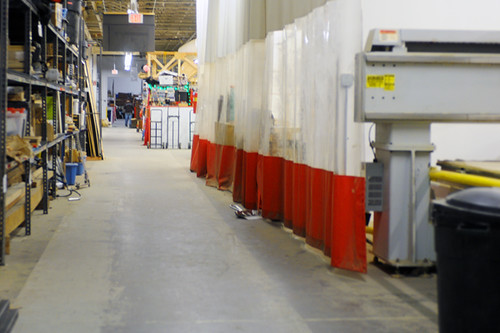
Some of you might be wondering where I've been over the last couple of days, either concerned or outraged over my lack of regular posts. Well, if you must know I have been up for the past 48 hours, watching a certain Interview on Oprah again and again, then endlessly analysing it with my internet friends on cycling forums ("Did you see his left eyebrow twitch when he said 'absolutely not' for the 8th time?").
No, I jest. But speaking of analysing facial expressions, readers might recall that I am a psychologist by training and former profession. And you know us psychologists, we love to experiment (that's professional jargon for "mess with people"). Well, last week my PsyPhone - which had grown dusty from lack of use - suddenly rang again, and I was asked to participate in One Last Assignment. "Come on boys," I groaned, wiping bicycle grease off my hands to the sound of jazz in background, "You know that I'm out of that racket." But they wouldn't have it. They needed me. Reluctantly I agreed.
The assignment was in the tradition of theRosenhan experiment. A team of us would infiltrate asylums throughout the country to observe and document their practices - from methods of diagnosis to treatment of inmates. I was assigned to the relatively newArtisan's Asylumin Somerville, Massachusetts.

Armed with notebook and camera, I approached the drab concrete exterior. The need for caution was immediately apparent, given this institution's stealth tactics. Tucked away on a side street lined with warehouses, the enormous building was hidden in plain sight in my very own neighbourhood. Thus it had managed to evade my attention despite being operational for an entire year.
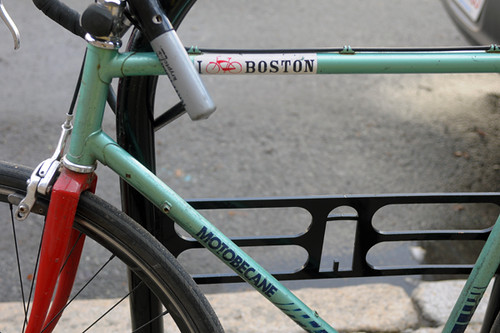
I examined the street conditions to gauge inmate demographics. Bicycles of all types were locked up to every available post. It was clear that I too would require a bicycle, so a to appear a convincing inmate candidate. Luckily, I already had one with me.
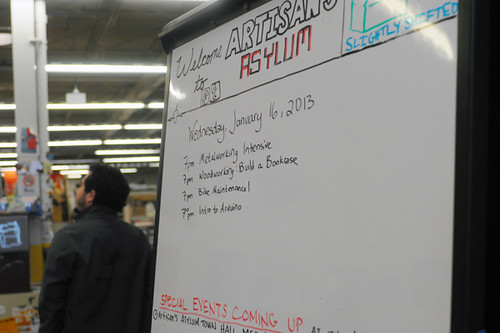
At the front desk, several staff members were in place to scrutinise visitors. According to plan, I walked in presenting with vague symptoms of artisanry. Among these I listed: painting, knitting, sewing, persistent compulsions toward bicycle design, and a one time incident of framebuilding. I did not elaborate, I did not exhibit flamboyantly artisanal behaviours, and my hands and clothing were relatively clean. Yet the staff member required no further evidence to admit me. On a notepad I saw them quickly scribble what looked like
psychosis framebuildis, poss. acute. Then another staff member came to escort me.

The inmates call him Dr. Carson, but we never see his face. He, as the other senior staff members, wear welding masks at all times. He appears to be legitimate, even if his interaction tactics unconventional.
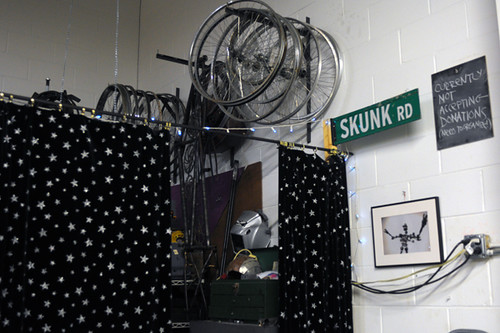
Another specialist is called Dr. Skunk. He interacts with inmates exclusively from behind a curtain. He too is purportedlylegitimate, and even runs his own clinic on the side.

Inmates appear well-kempt and not in apparent distress. Possibly they are medicated. Those who have been in the facility long term, enjoy a good degree of freedom. Some rely on two-wheeled devices to assist with mobility around the floor space.
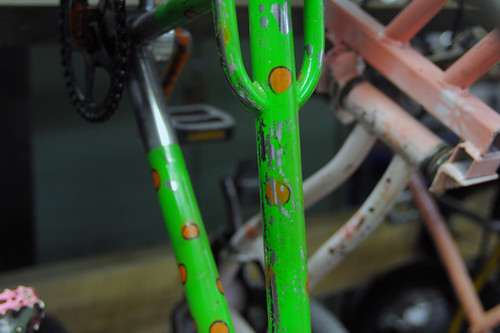
However, new inmates are required to wear green polka dotted metal "gowns," so that they are easily identified by members of staff. This contraption severely limited my speed and range of movements, making note taking and photography challenging.
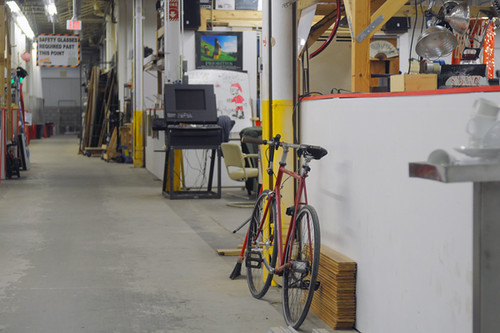
The interior of the Asylum is vast andlabyrinthine. Endless hallways connect shared spaces designated for inmate activities such as woodworking and metal working.

Private spaces are only partially walled off, allowing staff members to observe inmates.
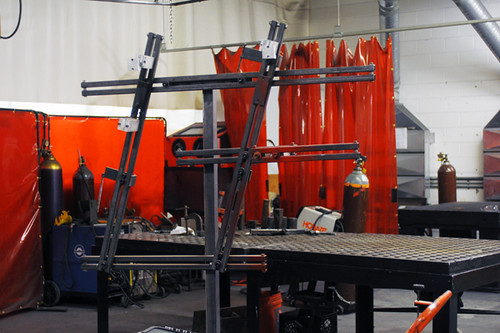
Primary colours are commonly used.
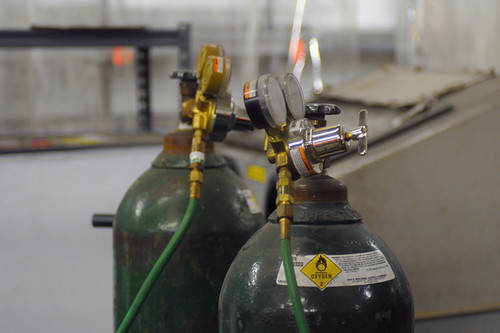
Evidence of traditional (some might say outdated) treatment models, such as brazing activities, abounds.
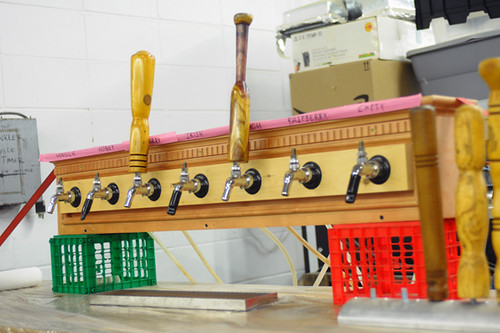
Nutrition available on the premises seems limited to beer and coffee, which the inmates are required to brew themselves.

They must also make the tools and dispensers necessary for its production and serving.
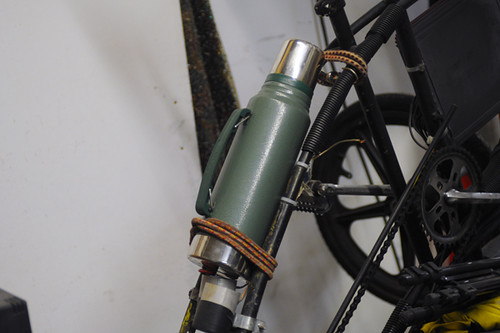
Each inmate receives a thermos in which to store hot liquid meals.
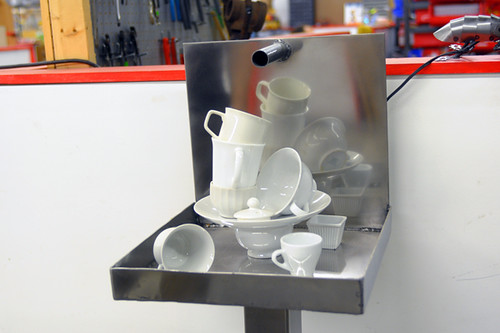
Yet I also noted sculptural renditions of used dishes piled up in several communal areas,
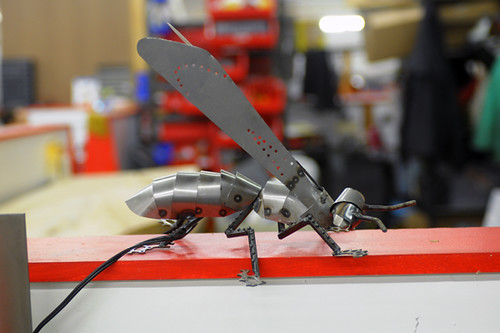
which could explain why the premises exhibit signs of insect, rodent, and possibly dragon infestations, in metal and paper form.

A variety of instructional signs guide inmate behaviour. Voluntary compliance rates are considerably higher than I've seen in other institutions.
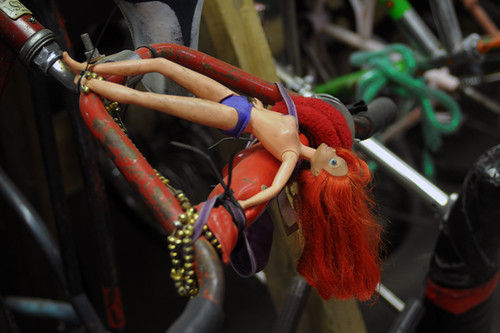
While I have not noticed any overt force or violence used on the inmates, some visual displays seemed designed as intimidation tactics to keep them under control.
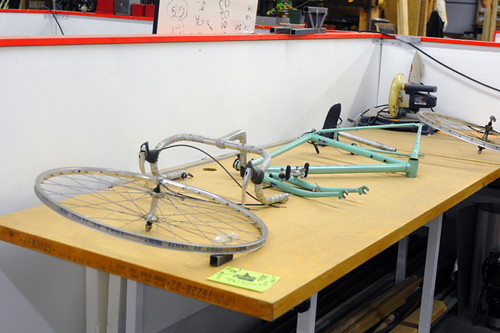
After my tour of the premises, I noted the staff members administering a subtle series of tests to confirm my diagnosis. First, I was exposed to a disassembled vintage Bianchi bicycle in the traditional "celeste" colour scheme while a hidden video camera measured my pupil response.
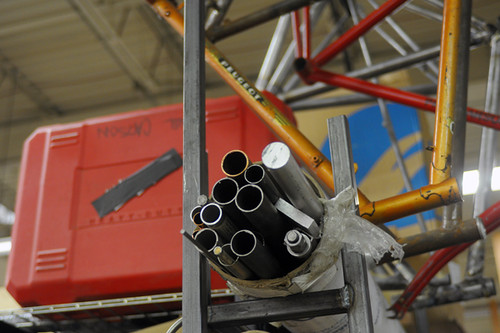
This procedure was then repeated with tubing, then lugs, then finally some unpainted brazed joints used as stimuli. At the end, Dr. Carson shook his head and jotted down some notes, which I saw to be a confirmation of the initial diagnosis.As far as I can tell, no other steps were taken to probe into my history or consider the appropriateness of my presence at the Asylum.
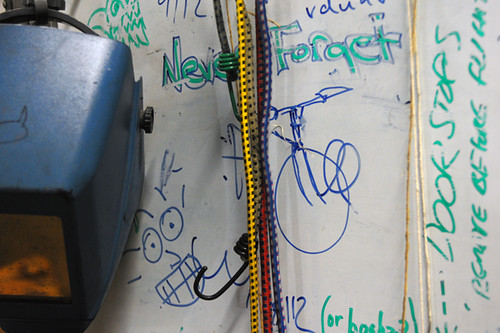
Following a brief consultation among staff members, my fate was decided. My condition was serious. I was to stay at the Asylum and undergo intensive treatment.
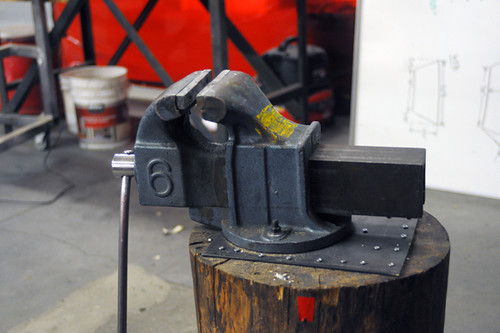
Devises to be used in this course of treatment were shown to me.
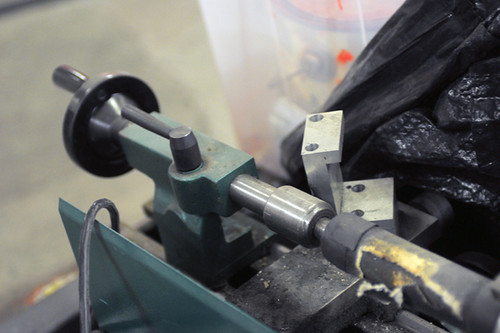
Noticing I appeared to have familiarity with them, only confirmed to the staff members the correctness of their diagnosis.
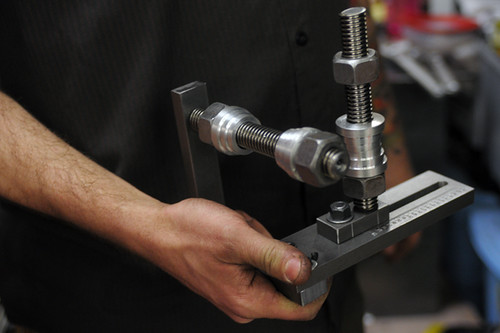 "Much of this is our own technology, made inhouse," Dr. Carson said soothingly. "I believe it will be effective in addressing your needs."
"Much of this is our own technology, made inhouse," Dr. Carson said soothingly. "I believe it will be effective in addressing your needs."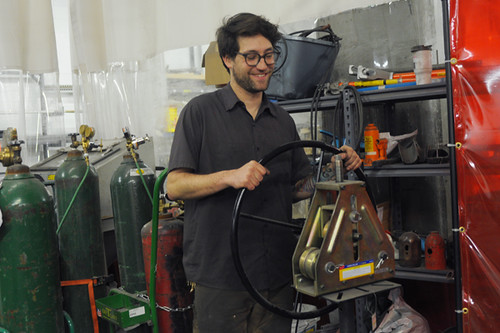
He then showed me other inmates undergoing similar treatment. How happy they were, how engaged, how productive.
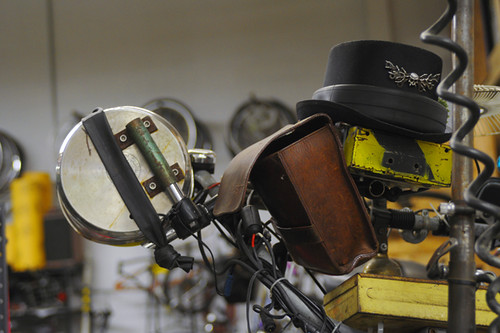
Having witnessed everything I came to witness at the Artisan's Asylum, at this stage I attempted to explain myself and depart. But denial is such a common symptom of the condition I was diagnosed with, that this proved to be challenging. I tried to present evidence contradicting my diagnosis. But the staff members only nodded gently. "The pupil test does not lie," said Dr. Carson. From behind his curtain, Dr. Skunk tapped out in Morse code: "you. must. remain."
At length I managed to get to a phone and contacted the project leader of my assignment. He listened to my report. A long silence on the other end then followed."But Dr. [Redacted]..." he finally said, "You have not worked with us for some time. We have no record of such a project as you describe."
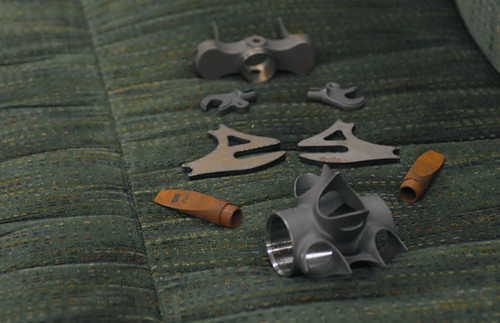
What can I say, dear readers. Sometimes life takes us to strange places. Places that exist in pocket universes right under our noses. Places that have brazing and welding facilities (and beginners' workshops, for anyone local interested). I still think the diagnosis is inaccurate, and I am still not sure how I got here. But maybe I will stay a while after all.
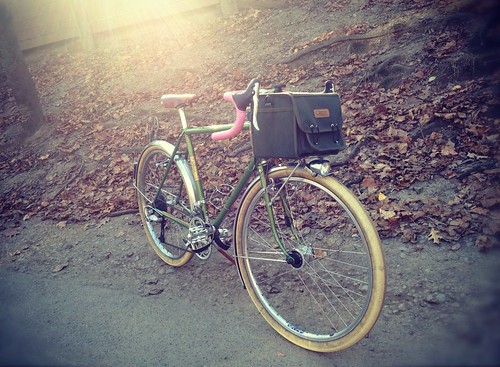 A couple of weeks ago I got the inexplicable urge to redo the handlebars on my Rivendellwith pink bar tape.I don't know. One day I was looking at the bike and suddenly felt that the earthtone and twine thing was getting kind of oppressive. The bike wanted to break free. Withthe streets growing more dreary with each passing day, a burst of colour was sure to break up the monotony. And that it certainly has: Now I feel as if I am riding a bike made of watermelon, or an enormous piece of tourmaline. It's nice and cheerful.
A couple of weeks ago I got the inexplicable urge to redo the handlebars on my Rivendellwith pink bar tape.I don't know. One day I was looking at the bike and suddenly felt that the earthtone and twine thing was getting kind of oppressive. The bike wanted to break free. Withthe streets growing more dreary with each passing day, a burst of colour was sure to break up the monotony. And that it certainly has: Now I feel as if I am riding a bike made of watermelon, or an enormous piece of tourmaline. It's nice and cheerful. Heavy stuff. And as usual I find myself disagreeing and agreeing all at the same time. On the one hand, there is Elly Blue's post about "reclaiming pink." There is also the fact that originally, pink was considered to be a colour for boys. Finally, there is the Maglia Rosa of the Giro d'Italia- shouldn't that association trump the girly one?
Heavy stuff. And as usual I find myself disagreeing and agreeing all at the same time. On the one hand, there is Elly Blue's post about "reclaiming pink." There is also the fact that originally, pink was considered to be a colour for boys. Finally, there is the Maglia Rosa of the Giro d'Italia- shouldn't that association trump the girly one?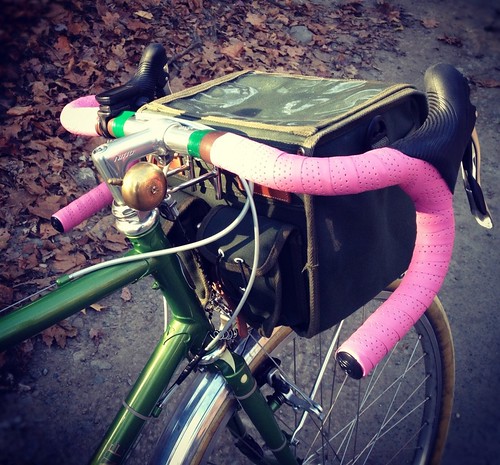 Ultimately, I think that pink is a more versatile colour than we give it credit for, particularly in the context of cycling. It is really all about presentation. I will probably not keep the pink bar tape on this bike in the long run, simply because it overshadows the elaborate lugwork that really deserves the starring role here. But for now I quite like it, stereotyped or not.
Ultimately, I think that pink is a more versatile colour than we give it credit for, particularly in the context of cycling. It is really all about presentation. I will probably not keep the pink bar tape on this bike in the long run, simply because it overshadows the elaborate lugwork that really deserves the starring role here. But for now I quite like it, stereotyped or not.




























 Watch out for rockfall between Camp Muir and Ingraham Flats! Lately, the weather has been less than ideal... I.e. rain, wind, clouds, rain, wind, clouds, rain, wind, clouds... Yuck, and more is expected for the next few days...
Watch out for rockfall between Camp Muir and Ingraham Flats! Lately, the weather has been less than ideal... I.e. rain, wind, clouds, rain, wind, clouds, rain, wind, clouds... Yuck, and more is expected for the next few days... Camp Muir is drawing more attention lately. Like
Camp Muir is drawing more attention lately. Like 

 Of all of the family pictures in Mom's albums, this is the only one I found that was taken outside during the winter. It was the winter of 1964 and shows me and my little sister. It looks like I lost my foot, or at the very least, my boot! The houses in the background belong to the neighbors.
Of all of the family pictures in Mom's albums, this is the only one I found that was taken outside during the winter. It was the winter of 1964 and shows me and my little sister. It looks like I lost my foot, or at the very least, my boot! The houses in the background belong to the neighbors. An early spring snowfall at our house at Karen Kove, north of Columbia City, March ...
An early spring snowfall at our house at Karen Kove, north of Columbia City, March ... My front porch. December ... It almost looks like this today. New fallen snow is pretty, even, dare I say, beautiful. That is, unless, like today, I had to go somewhere. Yesterday we got about 8" of the fluffy white stuff, which, considering conditions elsewhere, isn't all that much. But the wind was blowing too. I certainly didn't enjoy driving this morning on the slippery, snow-packed roads in below zero temperatures (with a -25°F wind chill). Brr.
My front porch. December ... It almost looks like this today. New fallen snow is pretty, even, dare I say, beautiful. That is, unless, like today, I had to go somewhere. Yesterday we got about 8" of the fluffy white stuff, which, considering conditions elsewhere, isn't all that much. But the wind was blowing too. I certainly didn't enjoy driving this morning on the slippery, snow-packed roads in below zero temperatures (with a -25°F wind chill). Brr.












 We stopped at the gas station across the road from where we normally buy Indian fry bread since there was no one selling it, and bought bean burritos and peanut butter cookies to have a quick picnic by Jemez Creek. There was some water in the creek but not as much as is normal during April. One photo is from inside a covered picnic area looking out toward the trees and road. Another is of a tree that has grown up through the roads, a real bonsai tree.
We stopped at the gas station across the road from where we normally buy Indian fry bread since there was no one selling it, and bought bean burritos and peanut butter cookies to have a quick picnic by Jemez Creek. There was some water in the creek but not as much as is normal during April. One photo is from inside a covered picnic area looking out toward the trees and road. Another is of a tree that has grown up through the roads, a real bonsai tree.